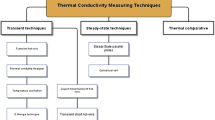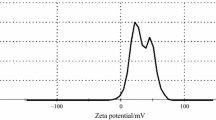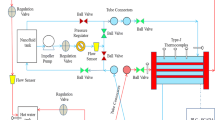Abstract
In this experimental work, a comparative study of convective heat transfer and drop in pressure characteristics of Alumina–Cu/water and Alumina–CNT/water hybrid nanofluids in fully developed laminar flow in a uniformly heated tube with circular cross section is presented. For this, Alumina–Cu hybrid nanoparticles (90:10 proportion was taken. Below this proportion for, e.g., 80:20, the nanofluid was not stable. Coagulation was happening) were prepared by using a hydrogen reduction technique. Characterization was done for the prepared powder through XRD and scanning electron microscope (SEM) to validate the chemical constitution, to establish the size of the particle and to investigate the morphology of surface. The synthesized Alumina–Cu hybrid nanopowder is dispersed in deionized water in an ultrasonic bath to form a well-dispersed 0.1% volume concentration of hybrid nanofluid. Carbon nanotube (CNT) functionalization was done by acid treatment method to convert the CNT surface from hydrophobic to hydrophilic. Scanning electron microscope was used for characterization of the aluminum oxide particles and functionalized multi-walled carbon nanotubes. To prepare 0.1% volume fraction of Alumina–CNT/water nanofluid, required quantities of Alumina powder and functionalized CNT were dispersed in deionized water in 90:10 proportion. Experiments were conducted in the laminar flow range with water, Alumina/water and hybrid nanofluids, and the results obtained have been compared. The convective heat transfer experimental results showed greater enhancement with Alumina–CNT/water hybrid fluid compared to Alumina–Cu/water hybrid fluid. The maximum enhancements of 30.65% and 20.48% in Nusselt number have been obtained for 0.3% volume fraction of Alumina–CNT/water hybrid nanofluid and Alumina–Cu/water hybrid nanofluid, respectively, at Reynolds number of 1350 as compared to the Nusselt number of water.










Similar content being viewed by others
Abbreviations
- \(\dot{m}\) :
-
Rate of mass flow
- A :
-
Area (m2)
- c p :
-
Specific heat (J/kg K)
- d :
-
Diameter of test section (m)
- f :
-
Friction factor
- h :
-
Heat transfer coefficient (W m−2 K−1)
- k :
-
Thermal conductivity (W m−1K−1)
- L :
-
Length of test section (m)
- Nu :
-
Nusselt number (hD/k)
- Pr :
-
Prandtl number (μcp/k)
- q” :
-
Heat flux (W m−2)
- Re :
-
Reynolds number (4m/πdμ)
- S :
-
Surface area (m2)
- T :
-
Temperature (°C)
- v :
-
Velocity of fluid (m s−1)
- x :
-
Axial distance from the tube entrance (m)
- ∆p :
-
Drop in pressure (Pa)
- μ :
-
Dynamic viscosity (kg m−2 s−1)
- ρ :
-
Density (kg m−3)
- φ :
-
Volume concentration (%)
- exp:
-
Experimental
- f:
-
Fluid
- I:
-
Inlet
- nf:
-
Nanofluid
- O:
-
Outlet
- pre:
-
Predicted
- s:
-
Solid phase
- w:
-
Wall
References
Choi SUS, Eastman JA. Enhancing thermal conductivity of fluids with nanoparticles. ASME-Publications-Fed 231. 99, 106. 1995.
Masuda H, Ebata A, Teramae K. Alteration of thermal conductivity and viscosity of liquid by dispersing ultra-fine particles. Dispersion of Alumina, SiO2 and TiO2 ultra-fine particles. Netsu Bussei. 1993;7(4):227–33.
Lee S, Choi SS, Li SA, Eastman JA. Measuring thermal conductivity of fluids containing oxide nanoparticles. J Heat Transf. 1999;121(2):280–9.
Eastman JA, Choi SU, Li S, Yu W, Thompson LJ. Anomalously increased effective thermal conductivities of ethylene glycol-based nanofluids containing copper nanoparticles. Appl Phys Lett. 2001;78(6):718–20.
Pak BC, Cho YI. Hydrodynamic and heat transfer study of dispersed fluids with submicron metallic oxide particles. Exp Heat Transf Int J. 1998;11(2):151–70.
Xuan Y, Li Q. Investigation on convective heat transfer and flow features of nanofluids. J Heat Transf. 2003;125(1):151–5.
Wen D, Ding Y. Experimental investigation into convective heat transfer of nanofluids at the entrance region under laminar flow conditions. Int J Heat Mass Transf. 2004;47(24):5181–8.
Yang Y, Zhang ZG, Grulke EA, Anderson WB, Wu G. Heat transfer properties of nanoparticle-in-fluid dispersions (nanofluids) in laminar flow. Int J Heat Mass Transf. 2005;48(6):1107–16.
Chandrasekar M, Suresh S, Bose AC. Experimental investigations and theoretical determination of thermal conductivity and viscosity of Alumina/water nanofluid. Exp Thermal Fluid Sci. 2010;34(2):210–6.
Suresh S, Chandrasekar M, Sekhar SC. Experimental studies on heat transfer and friction factor characteristics of CuO/water nanofluid under turbulent flow in a helically dimpled tube. Exp Thermal Fluid Sci. 2011;35(3):542–9.
Ding Y, Alias H, Wen D, Williams RA. Heat transfer of aqueous suspensions of carbon nanotubes (CNT nanofluids). Int J Heat Mass Transf. 2006;49(1–2):240–50.
Heris SZ, Etemad SG, Esfahany MN. Experimental investigation of oxide nanofluids laminar flow convective heat transfer. Int Commun Heat Mass Transf. 2006;33(4):529–35.
Duangthongsuk W, Wongwises S. Heat transfer enhancement and pressure drop characteristics of TiO2–water nanofluid in a double-tube counter flow heat exchanger. Int J Heat Mass Transf. 2009;52(7–8):2059–67.
Hwang KS, Jang SP, Choi SU. Flow and convective heat transfer characteristics of water-based Alumina nanofluids in fully developed laminar flow regime. Int J Heat Mass Transf. 2009;52(1–2):193–9.
Heris SZ, Esfahany MN, Etemad SGh. Experimental investigation of convective heat transfer of Alumina/water nanofluid in circular tube. Int J Heat Fluid Flow. 2007;28(2):203–10.
Anoop KB, Sundararajan T, Das SK. Effect of particle size on the convective heat transfer in nanofluid in the developing region. Int J Heat Mass Transf. 2009;52(9–10):2189–95.
Jena PK, Brocchi EA, Motta MS. In-situ formation of Cu–Alumina nano-scale composites by chemical routes and studies on their microstructures. Mater Sci Eng A. 2001;313(1–2):180–6.
Oh ST, Lee JS, Sekino T, Niihara K. Fabrication of Cu dispersed Alumina nanocomposites using Alumina/CuO and Alumina/Cu–nitrate mixtures. Scr Mater. 2001;44(8–9):2117–20.
Suresh S, Venkitaraj KP, Selvakumar P, Chandrasekar M. Synthesis of Alumina–Cu/water hybrid nanofluids using two step method and its thermo physical properties. Colloids Surf A. 2011;388(1–3):41–8.
Suresh S, Venkitaraj KP, Selvakumar P, Chandrasekar M. Effect of Alumina–Cu/water hybrid nanofluid in heat transfer. Exp Thermal Fluid Sci. 2012;38:54–60.
Rosca ID, Watari F, Uo M, Akasaka T. Oxidation of multiwalled carbon nanotubes by nitric acid. Carbon. 2005;43(15):3124–31. https://doi.org/10.1016/j.carbon.2005.06.019.
Keblinski P, Phillpot SR, Choi SU, Eastman JA. Mechanisms of heat flow in suspensions of nano-sized particles (nanofluids). Int J Heat Mass Transf. 2002;45(4):855–63.
Suresh S, Venkitaraj KP, Hameed MS, Sarangan J. Turbulent heat transfer and pressure drop characteristics of dilute water based Alumina–Cu hybrid nanofluids. J Nanosci Nanotechnol. 2014;14(3):2563–72.
Jaiswal AK, Wan M, Singh S, Singh DK, Yadav RR, Singh D, Mishra G. Experimental investigation of thermal conduction in copper–palladium nanofluids. J Nanofluids. 2016;5(4):496–501.
Ma J, Jia K, Li W, Zhang S. Investigation the forced convective heat transfer of Mn3O4–water nanofluids in transition region. J Nanofluids. 2016;5(1):186–90.
Lee JH, Hwang KS, Jang SP, Lee BH, Kim JH, Choi SU, Choi CJ. Effective viscosities and thermal conductivities of aqueous nanofluids containing low volume concentrations of Alumina nanoparticles. Int J Heat Mass Transf. 2008;51(11–12):2651–6.
Xuan Y, Roetzel W. Conceptions for heat transfer correlation of nanofluids. Int J Heat Mass Transf. 2000;43(19):3701–7.
Coleman HW, Steele WG. Experimental and uncertainty analysis for engineers. Hoboken: Wiley; 1989.
ANSI/ASME. Measurement uncertainty. 1-1985. 1986.
Author information
Authors and Affiliations
Corresponding author
Rights and permissions
About this article
Cite this article
Shahul Hameed, M., Suresh, S. & Singh, R.K. Comparative study of heat transfer and friction characteristics of water-based Alumina–copper and Alumina–CNT hybrid nanofluids in laminar flow through pipes. J Therm Anal Calorim 136, 243–253 (2019). https://doi.org/10.1007/s10973-018-7898-z
Received:
Accepted:
Published:
Issue Date:
DOI: https://doi.org/10.1007/s10973-018-7898-z




